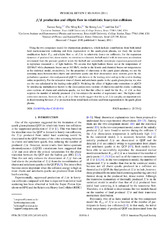| dc.creator | Song, Taesoo | |
| dc.creator | Ko, Che Ming | |
| dc.creator | Lee, Su Houng | |
| dc.creator | Xu, Jun. | |
| dc.date.accessioned | 2011-09-13T21:25:51Z | |
| dc.date.available | 2011-09-13T21:25:51Z | |
| dc.date.issued | 2011 | |
| dc.identifier.citation | Taesoo Song, Che Ming Ko, Su Houng Lee and Jun Xu. Phys.Rev.C 83 014914 2011. "Copyright (2011) by the American Physical Society." | en |
| dc.identifier.uri | http://dx.doi.org/10.1103/PhysRevC.83.014914 | |
| dc.identifier.uri | https://hdl.handle.net/1969.1/127123 | |
| dc.description | Journals published by the American Physical Society can be found at http://publish.aps.org/ | en |
| dc.description.abstract | Using the two-component model for charmonium production, which includes contributions from both initial hard nucleon-nucleon scattering and from regeneration in the quark-gluon plasma, we study the nuclear modification factor R(AA) and elliptic flow upsilon(2) of J/psi in relativistic heavy-ion collisions. For the expansion dynamics of produced hot, dense matter, we introduce a schematic fireball model with its transverse acceleration determined from the pressure gradient inside the fireball and azimuthally anisotropic expansion parametrized to reproduce measured upsilon(2) of light hadrons. We assume that light hadrons freeze out at the temperature of 120 MeV while charmonia freeze out at 160 MeV, similar to the kinetic and chemical freeze-out temperatures in the statistical model, respectively. For the properties of charmonia in the quark-gluon plasma, we use the screening mass between their charm and anticharm quarks and their dissociation cross sections given by the perturbative quantum chromodynamical (pQCD) calculations in the leading order and up to the next-to-leading order, respectively. For the relaxation time of charm and anticharm quarks in the quark-gluon plasma, we also use the one calculated in the leading-order pQCD. Modeling the effect of higher-order corrections in pQCD by introducing multiplicative factors to the dissociation cross sections of charmonia and the elastic scattering cross sections of charm and anticharm quarks, we find that this effect is small for the R(AA) of J/psi as they suppress the number of initially produced J/psi but enhance the number of regenerated ones. The higher-order corrections increase, however, the upsilon(2) of J/psi Our results suggest that the upsilon(2) of J/psi can play an important role in discriminating between J/psi production from initial hard collisions and from regeneration in the quark-gluon plasma. | en |
| dc.language.iso | en | |
| dc.publisher | American Physical Society | |
| dc.subject | QUARK-GLUON PLASMA | en |
| dc.subject | SUPPRESSION | en |
| dc.subject | Physics | en |
| dc.title | J/psi production and elliptic flow in relativistic heavy-ion collisions | en |
| dc.type | Article | en |
| local.department | Physics and Astronomy | en |


